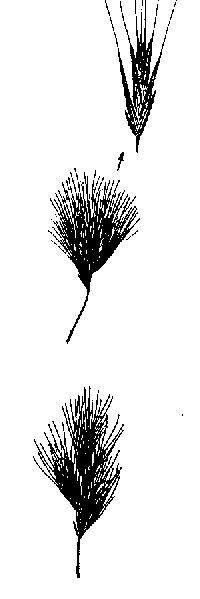|
Bromus madritensis ssp. rubens
|
|
|
|
Scientific name
|
Bromus madritensis ssp. rubens
|
|
Additional name information:
|
(L.) Husnot
|
|
Common name
|
foxtail chess; red brome, compact brome, Spanish brome
|
|
Synonymous scientific names
|
Bromus rubens
|
|
Closely related California natives
|
9
|
|
Closely related California non-natives:
|
13
|
|
Listed
|
CalEPPC Red Alert,CDFA nl
|
|
By:
|
Matthew Brooks
|
|
Distribution
|
|
|
HOW DO I RECOGNIZE IT?
Distinctive features:
|
Foxtail chess (Bromus madritensis ssp.
rubens) is characterized by a brush-like inflorescence that becomes a
distinctive purplish color at maturity. Plants growing in arid regions are
generally less robust with a more open and rigid panicle than those growing in
mesic regions. Seedlings are bright green and hairy, much like those of
cheatgrass (B. tectorum), the other common brome grass of arid and
semi-arid regions in southwestern North America. At maturity foxtail chess is erect with a panicle of
ascending florets on short pedicels arranged roughly equally around the
peduncle. Cheatgrass is more spreading, with a panicle of florets that are
attached to the peduncle by long, thin pedicels hanging loosely to one side,
nodding toward the ground. These characteristics persist for many years and are
useful in differentiating these species even after the florets have fallen from
the plant. Young plants are green, but foliage and inflorescences become
purplish at maturity, fading to light tan during the months following
senescence. Areas of foxtail chess infestation can be recognized at a distance
by their purplish color. Until recently, foxtail chess was considered a distinct
species, B. rubens, but it is now generally considered a subspecies of
its congener, B. madritensis (Wilken and Painter 1993, Sales
1994).
|
|
Description:
|
Poaceae. Annual. Stems: erect or ascending culms to 16 in (40 cm), bearing small soft hairs. Leaves: blades and sheaths with small, soft hairs; blade to 4 in (12.5 cm) x 0.2 in (5 mm); ligule to 0.2 in (5 mm), whitish. Inflorescence: to 3 in (75 mm) x 1.5 in (37 mm), stiffly erect, dense, ovoid at the top, wedge-shaped at the base; rachis internodes generally |
|
|
|
WHERE WOULD I FIND IT?
|
Foxtail chess (Bromus madritensis
ssp. rubens) is characterized by a brush-like inflorescence that becomes
a distinctive purplish color at maturity. Plants growing in arid regions are
generally less robust with a more open and rigid panicle than those growing in
mesic regions. Seedlings are bright green and hairy, much like those of
cheatgrass (B. tectorum), the other common brome grass of arid and
semi-arid regions in southwestern North America. At maturity foxtail chess is erect with a panicle of
ascending florets on short pedicels arranged roughly equally around the
peduncle. Cheatgrass is more spreading, with a panicle of florets that are
attached to the peduncle by long, thin pedicels hanging loosely to one side,
nodding toward the ground. These characteristics persist for many years and are
useful in differentiating these species even after the florets have fallen from
the plant. Young plants are green, but foliage and inflorescences become
purplish at maturity, fading to light tan during the months following
senescence. Areas of foxtail chess infestation can be recognized at a distance
by their purplish color. Until recently, foxtail chess was considered a distinct
species, B. rubens, but it is now generally considered a subspecies of
its congener, B. madritensis (Wilken and Painter 1993, Sales
1994).
|
|
WHERE DID IT COME FROM AND HOW IS IT SPREAD?
|
Foxtail chess is native to southern Europe, northern
Africa, and southwestern Asia, where it occurs from sea level to 4,260 feet
(1,300 m) on stony or sandy soils of cultivated fields and rangelands in arid to
mesic scrub and steppe regions (Bor 1968a, Jackson 1985). It was established in
California by 1848 (Frenkel 1977) and appears to have
naturalized there by the 1890s (Davidson 1907). By 1904 it could be found in
Kern, Mendocino, Orange, Amador, and Contra Costa counties (Robbins 1940).
Foxtail chess was common in the Mojave Desert by 1950 (Hunter 1991) and subsequently spread across
the deserts of California into southern Baja California and eastward to Texas. Its spread into the Great Basin appears to be limited by
sensitivity to low winter temperatures (Hulbert 1955) or competitive exclusion
by cheatgrass.
Long-distance dispersal of foxtail chess is accomplished by
seeds that lodge in animal fur and in loosely woven clothing. Short-distance
dispersal is aided by wind, which blows seeds along the ground until they settle
in eddies behind shrubs or rocks or in depressions in the ground.
|
|
WHAT PROBLEMS DOES IT CAUSE?
|
Altered patterns of wildfire, microhabitat
characteristics, and nutrient cycling caused by foxtail chess and competition
for soil nutrients and light negatively affect native annual plant populations
and revegetated plants (DÛªAntonio and Vitousek 1992). Foxtail chess is highly
flammable and promotes wildfires in desert plant communities where fires
historically have been infrequent (Brooks in press, Brooks 1998). Wildfires
convert woody perennial scrub into non-native annual grassland, which in turn
promotes further wildfires. In southern California both coastal and desert plant
communities are being ÛÏtype-convertedÛ into annual grassland dominated by
foxtail chess and other exotic annual plants (Brooks unpubl. data). Native
reptiles such as snakes and desert tortoises are sometimes killed in rapidly
moving fires (Fisher and Esque unpubl. data) fueled by this
species.
Although foxtail chess is sometimes grazed by livestock, it
is not considered a good forage plant and is generally regarded as having no
economic value (Bor 1968). Dried florets become entangled in wool, reducing its
value, and lodge in digestive tracts of some livestock, sometimes causing death.
|
|
HOW DOES IT GROW AND REPRODUCE?
|
Foxtail chess reproduces by seed only. It is generally considered a winter annual, emerging in early winter following rainfall and remaining largely quiescent until early spring, when rainfall and higher temperatures stimulate growth and flowering. Plants continue to flower until water stress kills them, typically by the middle of May. Populations increase during years of average to high rainfall. During years of low rainfall a high percentage of seedlings die prior to reproducing, thereby depleting the seedbank. Localized populations of foxtail chess can be virtually wiped out following a few years of drought, suggesting that seed dormancy may not last more than two to three years.
|
Like many successful annual weeds, foxtail chess can survive up to a year near human habitations and agricultural fields, where it receives enough supplemental water to survive through the summer. Biomass of this species can accumulate over many years, producing annual grasslands with a gray thatch of litter under a mass of tan and red erect and bent-over stems. In desert regions stems can remain rooted and upright for one to three years following death of the plant.
|
(click on photos to view larger image)
|
|
|
|
|
HOW CAN I GET RID OF IT?
|
|
|
Physical control:
|
Manual methods: Seedlings can be pulled
before they produce seeds, but this is practical only on a small scale. Hand
pulling may be an option to help revegetated plants become established during
the initial stages of restoration projects, but seed rain from plants in
adjacent areas will recolonize any open habitat.
Prescribed burning: Burning
aids the establishment of foxtail chess in most cases. One exception is fire
occurring in spring before seeds are fully mature or have otherwise dispersed to
the ground. Naturally occurring spring wildfires can reduce the above-ground
biomass of foxtail chess while enhancing that of native forbs in both coastal
and desert regions of southern California. Temperatures in fires in grassland
and scrub habitats easily kill foxtail chess seeds suspended in the flame zone,
but often are not high enough to kill seeds located at or below the soil surface
(Brooks 1998). Some perennial plants are more vulnerable to fire in spring than
in other seasons. However, the high water content of perennials during spring
can provide some protection if the intensity of the fire is
low.
|
|
Biological control:
|
Insects and fungi: Some species in the genus
Bromus are susceptible to both viral and fungal infections. A black smut
that destroys the inner part of the spikelet, thereby reducing or preventing
seed production, is naturally present in wild populations of foxtail chess in
California. Unfortunately, this fungus does
not reach levels of infestation that significantly affect population
size.
Grazing: Livestock grazing may be used in lieu of hand
pulling. Unfortunately, desirable native species are eaten as well, and
alterations to the soil caused by livestock may promote further establishment of
foxtail chess.
|
|
Chemical control:
|
Various herbicides, including glyphosate, have controlled foxtail chess in agricultural applications, but they are either not practical to use over the large expanses typically infested by foxtail chess or not currently registered for wildland use.
|




